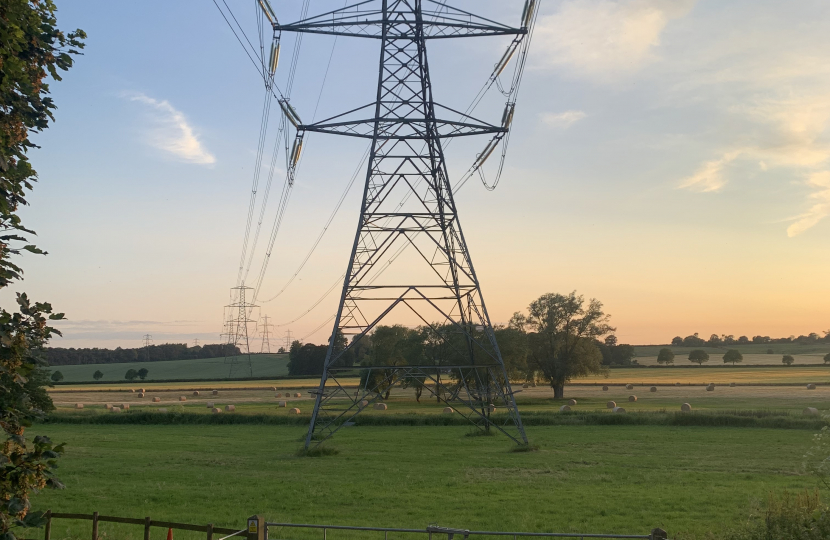
The route new overhead electricity powerlines will take, as they run across the Suffolk countryside, has finally been revealed.
National Grid wants to build a new 112-mile 400kV line, which it says is vital to help the UK achieve its aim of net zero emissions by 2050.
Now, the precise proposed route the line and its supporting pylons will take has been unveiled, running from Dunston, near Norwich, to Tilbury on the Thames estuary.
Previously, a wide corridor was suggested, giving only a vague idea of where the line would run.
The pylons, which will be 45 to 50 metres high, have been controversial, with critics saying the scheme will lead to the “annihilation of the countryside”.
But the company says the scheme is needed to increase supply as demand goes up, particularly as the country moves towards more reliance on wind power.
The National Grid says another proposed alternative – to run the lines along the seabed down the coast of East Anglia – would also cost too much.
However, following the publication of the latest proposals, campaigners, councillors and MPs in the region all reaffirmed their stance that an offshore alternative would be more cost-effective and less damaging to the environment.
Richard Rout, Suffolk County Council’s deputy leader and cabinet member for the environment, said: “Suffolk County Council welcomes the new details published in this consultation.
“But, fundamentally, our position remains that we prefer an integrated offshore solution, capable of delivery in a timely manner to support the UK’s energy security.
“Focusing on our local communities, I’m pleased to see proposals to reduce the harm caused by the project, but there is still significant potential to go further.
“This could include undergrounding of cables, along with the removal of smaller pylons across the network.
In particular, the council would expect to see comprehensive proposals to reduce the impact of infrastructure around the Bramford substation.
“We will now prepare our response to the proposals, and expect that National Grid engages effectively, to ensure the affected communities have a voice.”
The newly-published route map shows the Suffolk portion of the pylon line running east of Wattisham, Nedging Tye, Whatfield, Hadleigh and Layham, before entering the Dedham Vale Area of Natural Beauty (AONB).
After passing Polstead, Stoke-by-Nayland, Nayland and Boxted and crossing the county border, the route moves west, near to Wakes Colne, Chappel and Aldham, then continues south through Essex.
Campaigners have spoken of their dismay at the detailed map, which was published on Tuesday.
Rosie Pearson, who represents the Essex Suffolk Norfolk Pylons Action Group, said: “What a horrible map that people have had to wake up to.
“People will be looking to see if they have got a pylon tearing up their gardens, farmers will be looking to see if it will impact their ability to farm and businesses whether they will be disrupted.
“We are angry at the arrogance of National Grid when there is a better option on the table.
“There is not a council or MP that wouldn’t say that an offshore grid is a better option. We were told that they would be listening, but they are clearly not.”
Members of Parliament from the region met with National Grid officials yesterday afternoon to express their concerns that the new consultation had failed to properly consider credible alternatives to the proposed pylon line.
James Cartlidge, the MP for South Suffolk, said: “One of the main points that I’ll be raising in the meeting with National Grid is my profound disappointment that they have launched the latest stage of their consultation before the publication of ESO’s review of alternative offshore options.
“I warned last summer that National Grid were, at best, proposing a ‘straw man’ offshore option – one that is designed to be discounted.
“This is exactly what’s happened – they have offered a 220km offshore Norwich to Tilbury link which seems far from an optimal way to proceed.
“I hope that ESO will look at more credible options that include an actual offshore grid for East Anglia.
“It is worth noting that even with the ‘straw man’ option, which was previously estimated at a capital cost of £3.1billion to transport 6 gigawatts of power, this compares favourably to the Eastern Link from Scotland to north of England – costing £3.4bn for 4GW.
“The important thing for my constituents is not to just compare the costs of onshore vs offshore – it is to compare the costs of offshore options with others pursued in other parts of the UK.
“It’s therefore really important that the ESO study has committed to benchmarking potential offshore costs against those elsewhere in the country.
“Ultimately, all we want for our constituents is a fair deal, where they are shown the full facts of alternative credible options. Regrettably, National Grid have still not delivered this.”
Published by the Suffolk Free Press.


